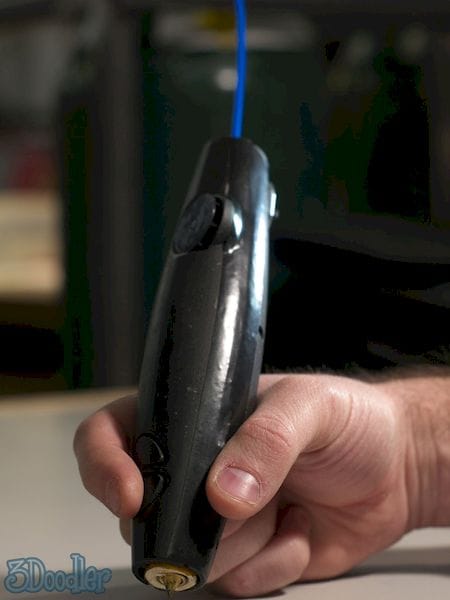![The 3Doodler, the original 3D Pen [Source: 3Doodler]](https://fabbaloo.com/wp-content/uploads/2020/05/image-asset_img_5eb09e0f5ba27.jpg)
This week’s question is one we’ve seen a couple of times and deserves an answer.
Reader Mike writes:
“HELLO
I NEED A 3D PEN THAT PRODUCES SILVER ,BRONZ ,….PIECES I MEAN METAL PIECES PLEASE GUIDE ME
1.WHICH PEN SHOULD I USE?
2.HOW CAN I BUY IT?”
First, what is a 3D pen? It’s definitely not a 3D printer, but is in fact a kind of handheld device that can be used to manually construct 3D structures. Instead of writing on a 2D surface as one would normally do with a pen, you hold the pen in 3D space and “draw” the desired structure, stroke by stroke. They first emerged in 2013 when 3Doodler launched a very successful Kickstarter.
Typically 3D pens are filament devices. They are effectively a handheld hot end. A filament is pulled in from the rear of the pen, heated in the middle and extruded from a nozzle at the front. It’s much like a 3D printer without the motion system – because YOU are the motion system.
As such, the objects produced with 3D pens are invariably inconsistent in dimensions and accuracy. It’s like sculpting versus CNC machining.
![An entire, wearable dress made with a 3D pen [Source: Fabbaloo]](https://fabbaloo.com/wp-content/uploads/2020/05/image-asset_img_5eb09e0fd82c0.jpg)
The filament-based pens are really a hot end, and require some insulation to prevent severe burns to your fingers. All filament 3D pens I am aware of are reasonably safe, so long as you don’t touch the exposed nozzle tip, which can be as hot as 250C.
There are a very few 3D pens that don’t use filament and instead use photopolymer resin. These devices are “cold”, and squirt out minute amounts of the resin, which then is immediately solidified by a UV light source located at the pen tip. When I say immediately, it’s not as fast as you might think, so these are a bit slow.
![A resin-based 3D Pen [Source: Creopop]](https://fabbaloo.com/wp-content/uploads/2020/05/image-asset_img_5eb09e1027c8e.jpg)
There’s another serious problem with resin-based 3D pens, and that’s the resin itself. Most photopolymer resins are in fact toxic and should be treated very carefully. Normally 3D printer setups using resin machines should be well ventilated to remove fumes, and operators must wear protective gloves to avoid skin touch with resin. Some operators will even wear respirators.
With those precautions being taken by resin 3D printer operators, it’s a bit hard to understand why someone would want to hold a resin 3D pen in their bare hands and risk slopping unsolidified resin on their own skin. I’d strongly recommend avoiding such devices entirely.
But back to Mike’s question: can he purchase a metal 3D pen?
I have two answers for this.
First answer: No. 3D printing of metal is an incredibly complex process, which can be seen in the massive costs required to implement any reasonable metal 3D printing operation. These costs are derived from the fact that metals require incredibly high melting temperatures, and that the metal powder frequently used is toxic to breath and sometimes even explosive.
If you really wanted a 3D pen “printing” metal, that would be impossible. Even if you used a metal wire (like a filament) instead of metal powder to avoid some of the complications, the heat required to melt the source material would bake your hand quickly. Either that or there would be so much insulation on the pen you wouldn’t be able to lift it — and that’s a requirement for 3D pen activities. They should be as light as possible. This would be much like welding. Maybe it is welding.
Second answer: Yes, kind of. It might be possible to obtain a standard filament-based 3D pen, and instead of 3D printing with regular polymers like PLA and ABS, you instead 3D printed with a special metal powder-infused filament. This would produce a 3D structure made of metal powder and polymer binder.
If you then placed the structure in a furnace, it could burn out the binder and sinter the metal powder together to form a more-or-less solid metal object. However, there are many complications.
By sintering you would reduce the size of the object by a hefty percentage, typically about 20%. This may compromise the geometry of the structure as 3D pen structures are typically rather sparse.
![A 3D pen-made shape with bulk geometry like this might survive sintering [Source: Fabbaloo]](https://fabbaloo.com/wp-content/uploads/2020/05/image-asset_img_5eb09e10824c8.jpg)
The sparse structure might not sinter properly, either, as it could collapse in mid-sinter if the mechanical stress were too much. I suspect this could work if you were creating simple, bulky-style objects.
Of course, you will require a sintering furnace too, which most people don’t likely own.
The answer to the Mike’s question of whether one can use a 3D pen to create metal objects is “No”, and “Maybe”.











